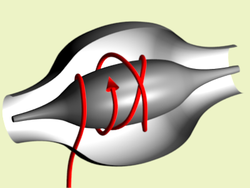- Orbitrap
-
An orbitrap is a type of mass spectrometer invented by Alexander Makarov. It consists of an outer barrel-like electrode and a coaxial inner spindle-like electrode that form an electrostatic field with quadro-logarithmic potential distribution.[1][2]
Contents
Principle of operation
In an orbitrap, ions are injected tangentially into the electric field between the electrodes and trapped because their electrostatic attraction to the inner electrode is balanced by centrifugal forces. Thus, ions cycle around the central electrode in rings. In addition, the ions also move back and forth along the axis of the central electrode. Therefore, ions of a specific mass-to-charge ratio move in rings which oscillate along the central spindle. The frequency of these harmonic oscillations is independent of the ion velocity and is inversely proportional to the square root of the mass-to-charge ratio (m/z or m/q). By sensing the ion oscillation in a manner similar to that used in FTICR-MS, the trap can be used as a mass analyzer. Orbitraps have a high mass accuracy (1–2 ppm), a high resolving power (up to 200,000) and a high dynamic range (around 5000).[3][4]
Like FTICR-MS the orbitrap resolving power is proportional to the number of harmonic oscillations of the ions; as a result, the resolving power is inversely proportional to the square root of m/z and proportional to acquisition time. Scigelova and Makarov[5] show the resolving power to be 7500 per 0.1 second transient at m/z 400. A transient being the duration that the time domain signal is acquired for. The resolving power decreases further as the m/z value increases so that at 4 times the m/z value (1600) the resolving power has halved to 3750 per 0.1 second. Approximately 0.1 seconds per transient is required for data processing, thus a 0.1 second transient has a cycle time of 0.2 seconds. These effects in combination result in a resolving power of 7500 at m/z 400 and 3750 at m/z 1600 when the orbitrap is operating at 5 acquisitions per second.
A linear ion trap can be used as a front end for the orbitrap; this combination has been marketed by Thermo Fisher Scientific as the LTQ Orbitrap.
History
The orbitrap is a modification of the ion trap developed by Kingdon in the early 1920s.[6] The Kingdon trap consists of a thin central wire and an outer cylindrical electrode. A static applied voltage results in a radial logarithmic potential between the electrodes. In 1981, Knight introduced a modified outer electrode that included an axial quadrupole term that confines the ions on the trap axis.[7] Neither the Kingdon nor the Knight configurations were reported to produce mass spectra.
See also
References
- ^ Makarov A. (2000). "Electrostatic axially harmonic orbital trapping: A high-performance technique of mass analysis". Analytical Chemistry : AC 72 (6): 1156–62. doi:10.1021/ac991131p.
- ^ Hu Q, Noll RJ, Li H, Makarov A, Hardman M, Graham Cooks R (2005). "The Orbitrap: a new mass spectrometer". Journal of mass spectrometry : JMS 40 (4): 430–43. doi:10.1002/jms.856. PMID 15838939.
- ^ Makarov A, Denisov E, Lange O, Horning S (2006). "Dynamic range of mass accuracy in LTQ Orbitrap hybrid mass spectrometer". J. Am. Soc. Mass Spectrom. 17 (7): 977–82. doi:10.1016/j.jasms.2006.03.006. PMID 16750636.
- ^ Makarov A, Denisov E, Kholomeev A, Balschun W, Lange O, Strupat K, Horning S (2006). "Performance evaluation of a hybrid linear ion trap/orbitrap mass spectrometer". Anal. Chem. 78 (7): 2113–20. doi:10.1021/ac0518811. PMID 16579588.
- ^ Scigelova M, Makarov A (2006). "Orbitrap mass analyzer - overview and applications in proteomics". Proteomics. 6 Suppl 2 (S2): 16–21. doi:10.1002/pmic.200600528. PMID 17031791.
- ^ Kingdon KH (1923). "A Method for the Neutralization of Electron Space Charge by Positive Ionization at Very Low Gas Pressures" (subscription required). Physical Review 21 (4): 408. Bibcode 1923PhRv...21..408K. doi:10.1103/PhysRev.21.408. http://link.aps.org/abstract/PR/v21/p408.
- ^ Knight, R. D. (1981). "Storage of ions from laser-produced plasmas". Applied Physics Letters 38 (4): 221–223. Bibcode 1981ApPhL..38..221K. doi:10.1063/1.92315.|url=http://link.aip.org/link/?APL/38/221/1%7Cformat=%7Caccessdate=2007-11-30
External links
Mass spectrometry Ion source Mass analyzer Detector MS combination Fragmentation Categories:- Mass analyzer
- Russian inventions
Wikimedia Foundation. 2010.

